Phil Lowe trains his Tamron 18-400mm Di II VC lens on wildlife and landscapes.
Images By Phil Lowe
Phil Lowe’s love affair with imagery started before he even made it to kindergarten. “My mom gave me an old Brownie box camera when I was 4 years old, and it left such an impression on me to be able to develop and see the pictures I’d taken,” he says. “I’ve been enamored with photography ever since.” Much of the past few decades in Phil’s professional life has been spent as a videographer and editor for the small screen, which has earned him six Emmys for his TV work; he’s been nominated for dozens of others. “Once I was working full time in television, I could afford my first nice camera, which was a film camera, and I started taking stills,” he says. “When digital came out, I resisted at first, because I thought I could get better results from shooting film and scanning it, but I soon learned what a pain in the neck that was.”
Phil soon made the full transition and is now the happy owner of three digital cameras. He acknowledges that working with what he calls the “gear snobs” in the videography industry, where people were accustomed to having $100,000 cameras at his disposal, made him wary on how well equipment would perform if it wasn’t the “best” (i.e., the most expensive). Then he got his hands on the Tamron 18-400mm Di II VC ultra-telephoto lens and saw he could have everything he wanted—sharpness, image quality, and versatility—in one lens at an affordable price point.
“The 18-400 now goes with me everywhere I go,” he says. “The richness and detail I’m able to achieve with this lens is simply amazing, and it performs like a pro at every focal length. Having such flexibility with my focal lengths is also a big plus for me; I can’t emphasize how convenient it is to not have to walk around with a full bag of lenses. The Vibration Compensation (VC) feature is especially handy, as I’m 61 now and not as steady as I used to be. That stabilization helps keep my handheld images, which is most of them, sharp.”
Phil has recently started trying his hand at landscape photography—”that lens allows me to create photos that are perfect for Shutterstock and other stock agencies”—but wildlife is what has remained close to his heart, and in front of his lens, the most. “Animal portraiture is what I really enjoy doing, and what I try to do is to capture the animals in their natural environment as much as possible,” he says. “For me, that means having the longest lens I can get my hands on and getting as close as I can, because I want to fill the frame with the animal, whether it’s a bird, deer, or marine creature. They say the eyes are the window to the soul, so I want to get as close as I can to offer viewers a look into the animals’ souls.”
Read on for Phil’s explainer on how he captured some recent wildlife images with the 18-400, as well as some photos of his new forays into landscapes:
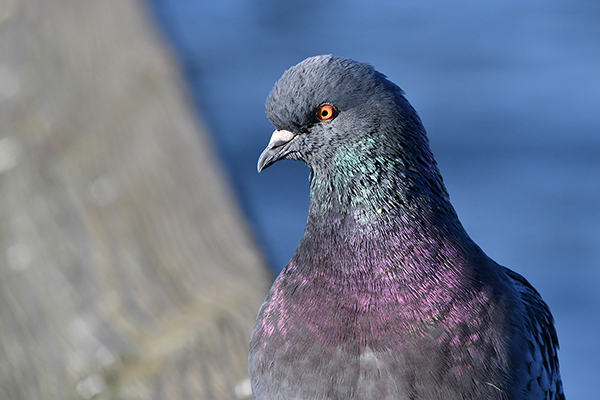
400mm, F/8, 1/1600th sec., ISO 800
When I’m photographing birds, I’m almost always trying to capture them at eye level. For one, most of these birds are a lot smaller than me, so I don’t want to shoot down on them. Shooting at eye level also can help get rid of any distracting background elements, depending on where I’m situated.
When I’m using the longer end of the 18-400, I ideally try to photograph a bird’s head in profile: By focusing right on the eye, with the bird parallel to the plane of the sensor, it doesn’t matter how shallow my depth-of-field is, because I’m getting the most important part of the bird in focus—the part that’s facing me directly. The detail in the pigeon’s feathers is what helps make this photo so eye-catching. In the meantime, the bokeh I’m able to achieve with this lens really makes the bird pop and stand out from the background.
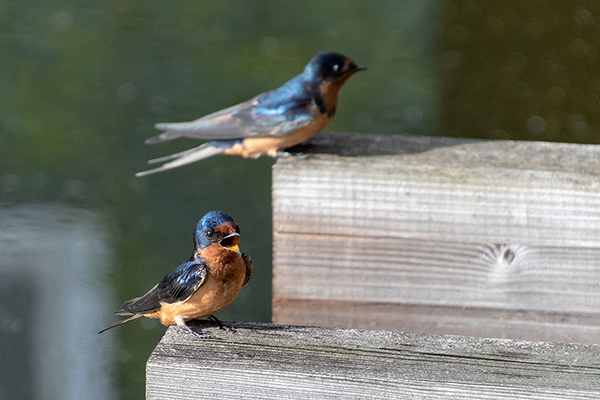
400mm, F/8, 1/640th sec., ISO 640
This photo of two barn swallows was taken at Nisqually National Wildlife Refuge in Olympia, Washington. There’s a walking bridge that takes you from the parking lot across the water to the visitor center. Barn swallows feed their young almost exclusively while they’re on the wing, so the adults almost never get any rest when they have young until they finally have a chance to land somewhere. That’s what these birds were doing: just sitting there, catching a much-needed break.
Again, I was positioned just a bit higher than the birds were—they were situated on girders underneath the bridge. I braced myself on the bridge railing to keep myself as steady as possible as I leaned over to capture the image. Even as close as that background bird is zoomed in at 400mm, it’s still nicely out of focus, with the water in the background, so your attention is drawn to the bird in front with its beak open. I really appreciate the kind of control I get with the 18-400 to achieve this type of effect.
Wildlife like this is so unpredictable—I call these little barn swallows “twitchy,” because they’re always moving around so quickly. That’s why when I’m shooting wildlife, I generally shoot in burst mode, which is how I captured the bird in front in mid-squawk. Here I was able to keep my shutter speed right at 1/640th because the birds were sitting and not moving as much. Typically, though, especially with birds, I’ll shoot closer to 1/1600th or 1/2000th of a second, even in broad daylight, at around F/8 to get a little more depth-of-field.
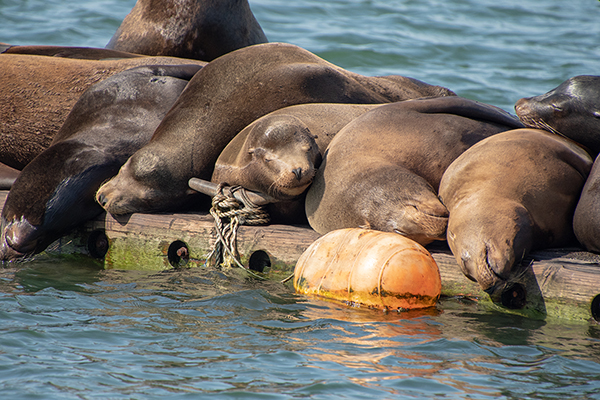
400mm, F/8, 1/1000th sec., ISO 640
Right along the Pacific Coast in Westport, Washington, is a commercial fishing port where the Westport Marina is located. It’s a wonderful place to take pictures, especially for wildlife like pelicans and sea lions. The sea lions you see lounging here one late afternoon were on a dock extension about 60 feet away from me.
Part of the reason I took this Tamron lens out was to compare it against another lens that cost about three times as much—and when it comes to image quality, the Tamron was outstanding. It blew me away. If you zoom in on this photo, you can see that every whisker, every bit of fur is tack sharp. I took hundreds of sea lion photos that day, and I achieved similar results, with super-sharp detail and the eyes on all the animals completely in focus.
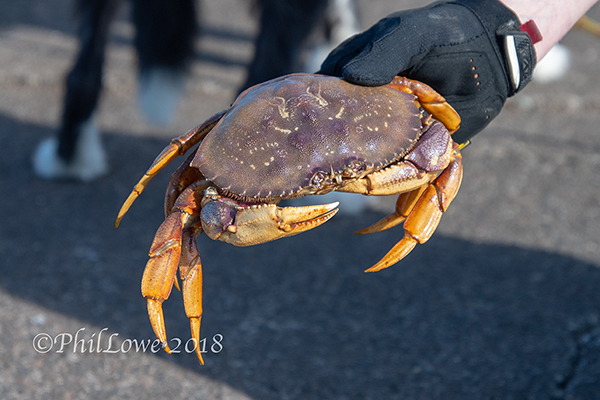
116mm, F/6.3, 1/1600th sec., ISO 640
I took a series of shots at this same marina of a crab fisherman working there. In the first photo, I captured a wide shot of the fisherman and his dog, who was sitting watching as he sifted through his catches of the day. Then I zoomed in a bit to get the fisherman reaching into the crab pot, the dog still watching him intently. Finally, I captured this close-up, shot at 116mm, which is a good example of using the middle of the 18-400’s focal-length range. Once again, the unbelievable detail this lens offers is evident. Zooming in to 100 percent at full resolution, you can see every little hair around the edge of the crab’s shell. When I’m looking at a lens, that’s the kind of detail I want to see. Stock agencies worth their salt place a premium on sharpness; they’ll reject a photo that isn’t as sharp as possible. I don’t hesitate to use this lens for my stock work for this reason.
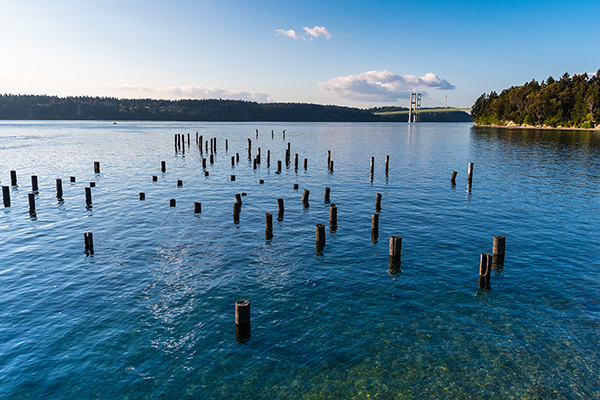
18mm, F/10, 1/400th sec., ISO 200
Another popular place to take pictures in Tacoma is Titlow Beach Park. This particular scene caught my eye because I had the pilings from where there used to be a pier in the foreground, with the Tacoma Narrows Bridge in the background.
My rule of thumb when shooting landscapes: Don’t put the horizon dead-center in the frame, because if all of the elements have equal relevance, then nothing has relevance. The idea here was to capture more of the pilings and less of the sky, because the sky wasn’t all that interesting that day—it was a clear, sunny afternoon, which is unique for western Washington. I also wanted the bridge in the background, so I composed the image using the rule of thirds: I placed the bridge near the axis points in the upper-right section, then filled the rest of the frame with the water and pilings.
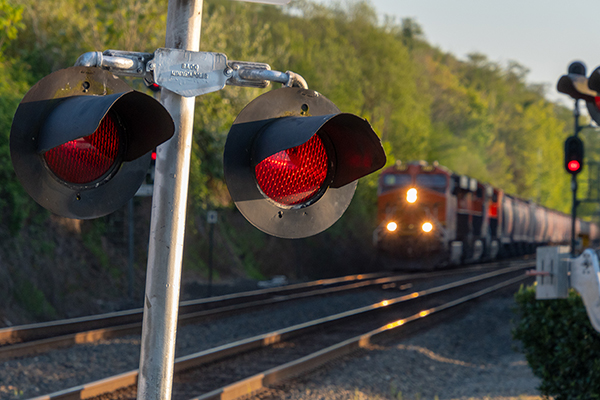
122mm, F/8, 1/640th sec., ISO 640
This shot was taken from that same location in Titlow Beach—I simply had to turn around from where I was facing the water so I could capture the train. I waited around for a half-hour for the train to come through just so I could get this shot exactly as you see it. I was again shooting this as a stock photo, trying to tell the story of auto safety, railroad crossings, and the dangers associated with driving near them.
If you look at the light post at the far right of the frame, it’s almost perfectly vertical. But the one in the foreground that you see leaning is because it actually is leaning. Everything in western Washington is kind of built into the side of a hill, and that was the case here—the ground wasn’t level. I thought it made for an interesting composition with that subtle element thrown in there.
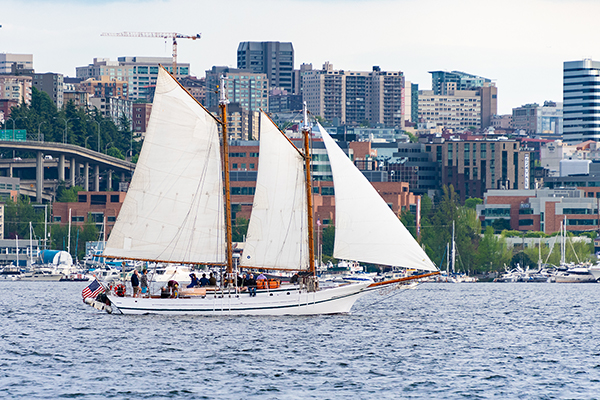
200mm, F/6, 1/500th sec., ISO 400
This photo was taken on Lake Union in Seattle, with me positioned on the north end of the lake looking south toward the city. I spotted this schooner on the water, about a quarter-mile away, and thought it was the perfect depiction of the city, showing people enjoying a charter boat ride on the lake. It was overcast and late in the evening, so the sun was quite low. Once again, I was so impressed with the incredibly sharp results I was able to get all the way at the 400mm end. If you zoom in on the photo, you can see the people hanging out on the boat’s deck and read the signage on the side. I cropped the picture just slightly so it would work well for stock.
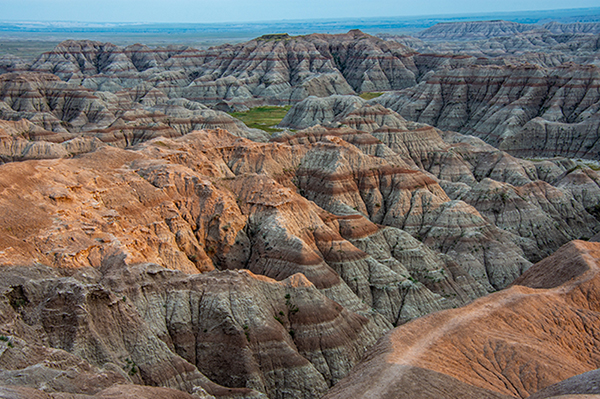
38mm, F/5.6, 1/250th sec., ISO 200
On the 30-mile Scenic Byway that winds through the park, there are various car pull-offs and parking lots where you can hop out and take some amazing pictures—it seems like there’s a new spot to take a photo of an incredible vista every few hundred feet or so. I’d pulled into a lot and stumbled upon this scene, in which you can see the result of thousands of years of water erosion. I love having an all-in-one zoom like the 18-400 in the national parks, because I can capture a jaw-dropping scene like this, then come in tight to capture the bighorn sheep or prairie dogs that are running around the park. I recommend this lens for anyone interested in travel, nature, or landscape photography for this very reason.